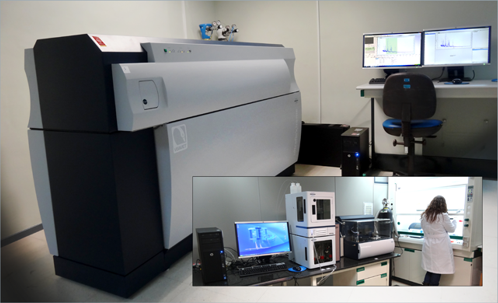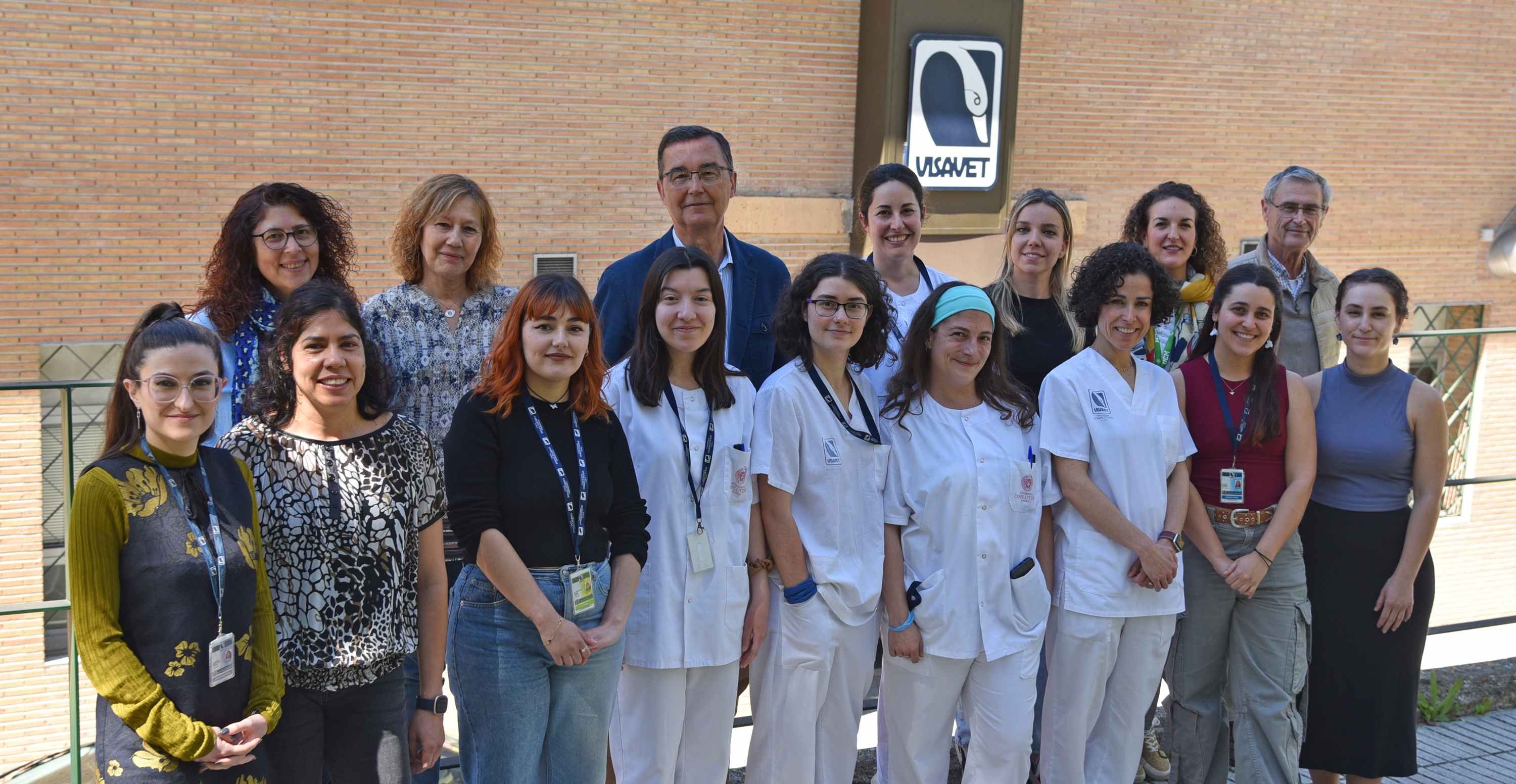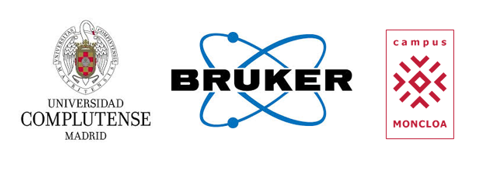Contact
This unit is focused on the study at the phenotypic, genomic and protein leves of pathogenic bacteria of veterinary interest. The main activities of the Unit are divided into three research lines that are closely related: clinical diagnosis (using phenotypic, molecular and chemotaxonomic methods, the molecular characterization of pathogenic bacteria of relevant clinical significance for epidemiological purposes and description of new bacterial species (bacterial taxonomy). The molecular characterization allows tracing epidemiological links between strains associated with outbreaks of disease, global epidemiological studies, monitoring programs, etc. Studies of bacterial taxonomy not only allow the description of new species but also allow, for example, the association of different pathogens with atypical clinical processes. Additionally, this unit integrates the Mass Spectrometry VISAVET- Bruker Platform enabling developing proteomics research studies in the field of microbiology and molecular histology.

This platform was acquired in the 2011 call of the Equipment Acquisition and Scientific-Technical Infrastructure Adequacy (CAIMON) of Campus MONCLOA and enable the constitution of a service to enhance the research on campus.
The VISAVET-BRUKER service is made within the framework of a collaboration agreement between the Complutense University and Bruker Daltonik GMBH.
Application for identification and classification of bacteria and fungi. The identification is based on the comparison of the spectral fingerprints of the microorganism with those existing in the database (composed for more than 4000 entries). The technique is an accurate, simple, fast and reliable alternative for the identification of bacteria with traditional methods.
Application of MALDI TOF MS for the two dimensional acquisition of mass spectra from fresh tissue section. Image MALDI is ideal for the identification of protein markers and other small molecules in tissue sections.
System allowing the identification of proteins primarily by determining its peptide fingerprint. Enables Proteomics studies.
Investigation

Research lines:

Next scientific publications:
- Polo C., Garcia-Seco T., Garcia N., Fernandez-Benito V., Briones V., Diez-Guerrier A., Alvarez J., Dominguez L. and Perez-Sancho M.. Time, temperature and media: the three keys to improve the recovery of Campylobacter fetus subsp. venerealis from preputial bull samples. Veterinary Research Communications. In Press (A)
Last scientific publications:
- Sánchez-Morales L., Porras N., Garcia-Seco T., Perez-Sancho M., Cruz F., Chinchilla-Rodríguez B., Barroso-Arevalo S., Diaz-de Frutos M., Buendia A., Moreno I., Briones V., Risalde MA., de la Fuente J., Juste R., Garrido J., Balseiro A., Gortazar C., Rodriguez-Bertos A., Dominguez M. and Dominguez L.. Neuropathological lesions in intravenous BCG-stimulated K18-hACE2 mice challenged with SARS-CoV-2. Veterinary Research, 55(1):71. 2024. (A)
- Scarpellini R., Leal Velez de Mendizábal L., Quevedo-Caraballo S., Blanco JL., Garcia ME., Perez-Sancho M., Portero-Fuentes M., Penelo S., Esposito E., Mondo E. and Piva S.. Active surveillance of antimicrobial resistance in companion animals: A pilot study in a Spanish Veterinary Teaching Hospital. Comparative Immunology, Microbiology and Infectious Diseases, 108:102169. 2024. (A)
- Bondavalli F., Colussi S., Pastorino P., Zanoli A., Bezzo Llufrío T., Fernandez-Garayzabal JF., Luigi Acutis P. and Prearo M.. First Report of Lactococcus petauri in the Pumpkinseed (Lepomis gibbosus) from Candia Lake (Northwestern Italy). Fishes, https://doi.org/10.3390/fishes9040117. 2024. (A)
- Vela AI., Blanco MM., Colussi S., Kotzamanidis C., Prearo M., Altinok I., Acutis P., Volpatti D., Alba P., Feltrin F., Ianzano A., Dominguez L. and Fernandez-Garayzabal JF.. The association of Lactococcus petauri with lactococcosis is older than expected. Aquaculture (Amsterdam, Netherlands), 578(740057):1-7. 2024. (A)
- Vargas-Castro I., Crespo-Picazo JL., Fayos M., Jimenez-Martinez MA., Torre-Fuentes L., Alvarez J., Moura AE., Hernandez M., Buendia A., Barroso-Arevalo S., Garcia-Seco T., Perez-Sancho M., de Miguel MJ., Andres-Barranco S., Marco-Cabedo V., Penin-Villahoz G., Munoz PM., Dominguez L., Garcia-Parraga D. and Sanchez-Vizcaino JM.. New insights into the pathogenesis and transmission of Brucella pinnipedialis: systemic infection in two bottlenose dolphins (Tursiops truncatus). Microbiology Spectrum, e0199723. 2023. (A)

Last PhD thesis supervised:
- Coral Polo Vaquero. New approaches in the control of infectious fertility problems in extensive cattle. 2023. (Doctorado Industrial)
- Leydis Zamora Morales. Estudio taxonómico de bacterias relacionadas con el Síndrome del Alevín de la trucha. 2015. (Premio Laboratorios Ovejero)
- Verónica Sánchez del Rey. Estructura y diversidad de la población de Streptococcus suis presente en el ganado porcino, jabalí y conejo silvestre. 2015.
- Monica Aguado Urda. Caracterización y análisis funcional del genoma de Lactococcus garvieae. 2014.
- Verena Blume Serrano. Molecular characterization of Streptococcus suis (serotypes 2 and 9) isolated from swine in Spain. 2010.
Outreach

Last outreach publications:
- Sánchez-Morales L.. ¡Invasión silenciosa! Cómo las especies exóticas invasoras están cambiando nuestros ecosistemas. Unidad de Divulgación Científica y Transferencia, Universidad Complutense. 2024.
- Perez-Sancho M., Vela AI., Garcia-Seco T., Gottschalk M., Dominguez L. and Fernandez-Garayzabal JF.. Assessment of MALDI-TOF MS as alternative tool for Streptococcus suis identification. Applications of STEM (Science, Technology, Engineering and Mathematics) tools in microbiology of infectious diseases. Ed. 1. 113-118, Frontiers. 2017.
- Bezos J., Cots M. and Valls JL.. La Bronquitis Infecciosa Aviar. Merial Laboratorios S.A.. 2016.
- Lopez-Campos G., Aguado-Urda M., Blanco MM., Gibello A., Cutuli MT., Lopez-Alonso V., Martin-Sanchez F. and Fernandez-Garayzabal JF.. Lactococcus garvieae: a small bacteria and a big data world. Health Information Science and System, 24;3:S5, Universidad Complutense. 2015.
- Barrera R., Cerda P., Dominguez L., Fernandez-Garayzabal JF., Galiana F., Gomez J., Hernandez A., Hernandez JM., Herrero M., Lopez A., Lopez J., Meseguer E., Molina JR., Palacios E., Portela S., Ruiz F., Santiago JM., Seiz R., Tejedor JL., Torrent F., Valles M., Vela AI. and Villarroel M.. Acuicultura en aguas continentales. Ministerio de Medio Ambiente y Medio Rural y Marino. 2011.

Last communications:
- Sánchez-Morales L.. Avances en el estudio del SARS-CoV-2 y la implicación de la inmunidad entrenada en la enfermedad. Seminarios de Investigación Doctorado en Veterinaria. 2024. (Oral communication)
- Vargas-Castro I., Crespo JL., Fayos M., Jimenez-Martinez MA., Torre-Fuentes L., Alvarez J., Moura AE., Hernandez M., Buendia A., Barroso-Arevalo S., Garcia-Seco T., Perez-Sancho M., de Miguel MJ., Andres-Barranco S., Marco-Cabedo V., Penin-Villahoz G., Munoz PM., Dominguez L., Garcia-Parraga D. and Sanchez-Vizcaino JM.. Profundizando en la patogénesis y transmisión de Brucella pinnipedialis en delfines mulares varados. 35ª Conferencia Anual de la Sociedad Europea de Cetáceos. 2024. (Oral communication)
- Perez-Sancho M.. Muestreos no invasivos: ¿está la clave para la detección de patógenos y el análisis de su virulencia y resistencia a antibióticos fuera del animal?. XXVI Edición del Simposio Nacional AVEDILA. 2023. (Oral communication)
- Sánchez-Morales L., Cruz F., Garcia-Seco T., Porras N., Acurio Gutsche KL., Perez-Domingo A., Barroso-Arevalo S., Diaz-de Frutos M., Perez-Sancho M. and Dominguez L.. Parámetros biopatológicos evaluados en sangre y plasma de ratones k18-hACE2 desafiados con SARS-CoV-2. XXVI Edición del Simposio Nacional AVEDILA. 2023. (Poster communication)
- Perez-Sancho M.. Identificación y caracterización microbiana mediante espectrometría de masas. Centro VISAVET-UCM: cómo se trabaja en un laboratorio de alta seguridad biológica. XXIII Semana de la Ciencia Madri+d. 2023. (Oral communication)



